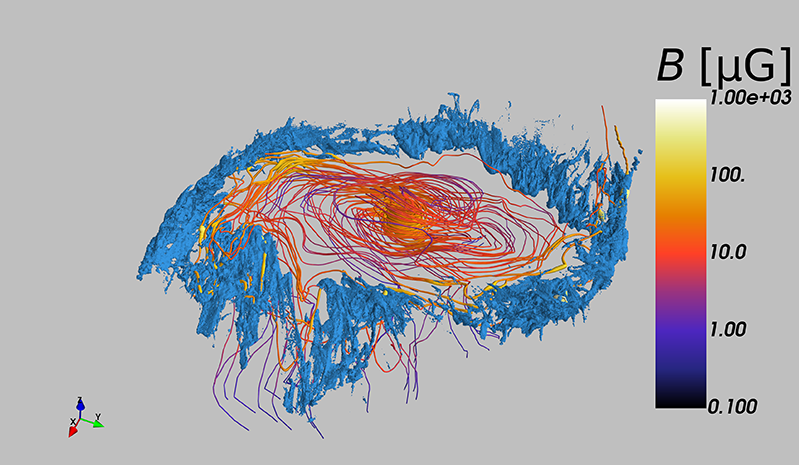Magnetic Fields and Gas Dynamics in the Central Region of our Milky Way
| Project Manager | Prof. Dr. Ralf Klessen |
|---|---|
| Principal Investigator | Prof. Dr. Ralf Klessen |
| Author of this Article | Dr. Robin Tress |
| Affiliation | Heidelberg University, École Polytechnique Fédérale de Lausanne and 32 other institutions |
| Project duration | 9/2016 - 11/2025 |
| Platform used | bwForCluster BinAC & Helix, SDS@hd |
| bwHPC Domain | Astrophysics |
| DOI of Publication | https://doi.org/10.1051/0004-6361/202450035 |
| Project added | 22.04.2025 |
The Milky Way has a prominent barred stellar structure in its central region. This significantly impacts the local gas flow, and torques exerted by this rigidly rotating structure drives copious gas inflow, with matter accumulating in a central structure called “The Central Molecular Zone” of about 100 pc in radius. The question of what causes the final sprint of the gas towards the central supermassive black hole is still largely unexplored as the torques from the bar are too small to explain the observed inflow in this very central region.
In this study we investigate the role that magnetic fields might play in this puzzle. Magnetic fields are ubiquitous in the Universe, and their dynamical evolution is intimately coupled to flow in the medium they permeate. As the interstellar medium drags magnetic field lines along on its way to build up the Central Molecular Zone, it can generate strong magnetic fields by compression. Turbulence then further enhances the magnetic fields through dynamo action, leading to values up to a thousand times higher than what we observe in our solar neighbourhood. This is a highly non-linear multi-scale process, and multi-phase magnetohydrodynamic (MHD) simulations are needed to address this problem. Specifically, we solve the time-dependent MHD equations in three dimensions using the moving-mesh code Arepo. The gas streams in an external potential that reproduces key features of the Milky Way, and the chemical state of the medium is followed by evaluating a complex chemical network in every cell at each time step. The code is efficiently parallelized and the simulations reported here had about 100 million cells.
We find that the magnetic field in the inner regions of the Milky Way can be decomposed into a regular time-averaged component and an irregular turbulent component. It aligns well with the velocity vectors of the gas in the Galactic plane and becomes increasingly poloidal at large heights. We also argue that the magneto-rotational instability (MRI) causes an inflow of matter towards the black hole in the center of the Galaxy. The gas velocity dispersion inferred from our simulations is lower than the measured values, suggesting that other processes such as stellar feedback are necessary to explain the observations. Dynamo action driven by differential rotation and the MRI amplifies the magnetic fields in the Galactic center region until they saturate at values of the order of 100 µG.
Figure descriptions:
Figure 8: Face-on and edge-on views of the interstellar medium in the central region of the simulated Milky Way analogue.The magnetic field lines are superimposed on the gas distribution. This structure is the so called “Central Molecular Zone” and it is fuelled by the gas streams seen coming in at the edges of the image, induced by the Galactic bar.
Figure 10 a and b: A 3D rendering of the simulated Central Molecular Zone. A few selected magnetic field lines are shown, coloured by their local intensity. These images help us understand the morphology of the magnetic field in the region, shaped by the complex gas motions.
Movies are availabe at https://www.aanda.org/articles/aa/olm/2024/11/aa50035-24/aa50035-24.html.



